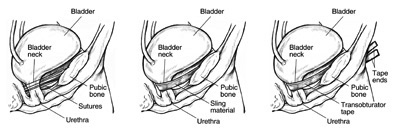Stress urinary incontinence (SUI) is a common, treatable condition in which sudden movements put stress on the bladder, causing urine to leak out involuntarily (incontinence).
Involuntary urine leakage may occur when laughing, sneezing, jumping, lifting a heavy object, or exercising.
Stress urinary incontinence is one of the most common types of urinary incontinence among women. About 1 in 3 women suffers from stress urinary incontinence.
Unfortunately, over 1/2 of women with stress urinary incontinence have never mentioned it to their doctor. Many women assume stress urinary incontinence is just a natural part of aging or an inevitable consequence of having children. Misconceptions like these prevent many women from learning that there are treatment options for stress urinary incontinence.
Causes of Stress Urinary Incontinence
Stress urinary incontinence occurs when pelvic muscles supporting the bladder and urethra have been damaged or weakened, so that they may not hold the urethra in its correct position. Sudden movements from the diaphragm put stress on the bladder, causing the urethra to lose its seal and allowing urine to leak out.
Factors that can lead to stress urinary incontinence include:
- Pregnancy and childbirth
- Frequent heavy lifting
- Estrogen deficiency or menopause
- Obesity
Incontinence can also be a symptom of other pelvic health issues, like pelvic organ prolapse , a condition in which organs in the pelvic region shift out of their normal position.
Treatments for Stress Urinary Incontinence
Stress urinary incontinence is treatable at any age, but not all approaches work for every person or for every type of incontinence.
Your doctor will recommend a treatment based on several factors including:
- the duration and severity of incontinence
- the woman's age
- the presence of other medical conditions, such as obesity
- responses to past treatments
Nonsurgical treatment options
Nonsurgical approach for treating stress urinary incontinence include the following:
- Behavioral/Muscle Therapy: Therapy often starts with Kegel exercises to help strengthen the pelvic floor muscles. Depending on the severity of your condition, however, Kegels may not bring sufficient relief.
- Biofeedback: In this method, the patient exercises the pelvic floor muscles while connected to an electrical sensing device. The device provides “feedback” to help you learn how to better control these muscles. Over time, biofeedback can help you use your pelvic muscles to decrease sudden urges to urinate and lessen certain types of pelvic pain.
- Electrical stimulation: This approach aids pelvic floor exercises by isolating the muscles involved for extra stimulus.
- Medication: Some types of urinary incontinence, like urge incontinence, can be treated with medications.
For women whose incontinence is caused by pelvic organ prolapse (POP), a pessary can be inserted into the vagina to support and reposition the pelvic area. This small device can help relieve mild symptoms of pelvic organ prolapse, including incontinence. In some instances, a pessary may make urinary incontinence worse; if this happens,see your doctor to discuss other treatment options.
Surgical treatment options
While mild symptoms of incontinence may be treated using the methods described above, women with more serious symptoms may respond best to a surgical procedure.
Today’s minimally invasive options mean you may be able to treat incontinence with a simple outpatient procedure. In one type of treatment, your surgeon inserts a tape-like strip of mesh through very small incisions in the abdomen or vagina to support the urethra. The mesh acts as a supportive sling, allowing the urethra to stay closed when appropriate.

Patients with incontinence caused by pelvic organ prolapse may opt for a pelvic floor repair procedure. During the procedure, the surgeon repositions the prolapsed or “dropped” organs and secures them to the surrounding tissues and ligaments, sometimes reinforced with a strip of soft mesh.
Be sure to talk to a doctor about the treatment options that may be best for you.
Source: National Institute of Diabetes and Digestive and Kidney Diseases
Last updated : 1/8/2019